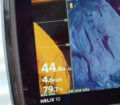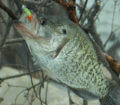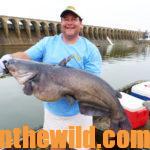Editor’s Note: My late friend, bass-fishing phenom Ken Cook of Meers, Oklahoma, won both a Bassmasters Classic Mega Bucks tournament. But before his bass-fishing fame, Cook was a fisheries biologist and loved to crappie fish. Cook gave me some great tips for catching crappie some years ago that produce summertime crappie today.
 During the spring spawn in many lakes, a person can just about walk from boat to boat as anglers attack the shoreline, harvesting the rich bounty of crappie that move into shallow water to lay their eggs. But when the spawn is over, and the crappie leave the shallows, so do the fishermen. Although still plenty of crappie are in a lake to be caught, many anglers don’t know where to find the crappie or how to catch them in warm weather.
During the spring spawn in many lakes, a person can just about walk from boat to boat as anglers attack the shoreline, harvesting the rich bounty of crappie that move into shallow water to lay their eggs. But when the spawn is over, and the crappie leave the shallows, so do the fishermen. Although still plenty of crappie are in a lake to be caught, many anglers don’t know where to find the crappie or how to catch them in warm weather.
“Ninety-five percent of the anglers who fish for crappie angle only the visible cover along the shore that they can see,” Cook told me. “However, the crappie are only in that shallow water cover for approximately 2 months of the year. The rest of the time, they usually are holding in deep water along some type of bottom break structure and near or in some kind of cover. If you want to take crappie in the summertime, you must learn how to use your depth finder and locate the fish in open water, because that’s what summertime crappie fishing is all about.”
Often when bass fishing is slow in the summer, and the bass angler gets those little pecks on his line, he can convert over to crappie fishing, catch a good mess of slabs, even if the bass won’t hit, take the crappie home to eat and still catch and release the bass. Ken Cook had vast knowledge of fish and said, “Fishermen can eat crappie because crappie are such prolific fish. Most lakes across the country home healthy crappie populations that can be harvested heavily each year without impacting the resource. Crappie can withstand much more fishing pressure than bass. In many parts of the country, crappie are so overpopulated that the fish’s growth becomes stunted. But do abide by the rules and regulations set by the fisheries departments in each state, since fisheries biologists know what they’re doing.”
 Cook believed that crappie fishing in the middle of the day during the summertime would provide a break for the bass angler who knew that mid-day fishing for largemouths could be tough. “I’ve never met a fish I didn’t like, and crappie not only provide a fun tug on the line in the middle of the day, but they’re a delicious-eating fish and a good freezer stocker,” Cook explained. “Although bass seem to be most active early and late during the hot summer months, actually crappie may feed three or four times a day and usually are more likely to be active in the middle of the day than the bass. There’s no reason why the bass fisherman can’t return home with a mess of fish to eat – if he uses his bass tactics to catch crappie when the bass aren’t biting.
Cook believed that crappie fishing in the middle of the day during the summertime would provide a break for the bass angler who knew that mid-day fishing for largemouths could be tough. “I’ve never met a fish I didn’t like, and crappie not only provide a fun tug on the line in the middle of the day, but they’re a delicious-eating fish and a good freezer stocker,” Cook explained. “Although bass seem to be most active early and late during the hot summer months, actually crappie may feed three or four times a day and usually are more likely to be active in the middle of the day than the bass. There’s no reason why the bass fisherman can’t return home with a mess of fish to eat – if he uses his bass tactics to catch crappie when the bass aren’t biting.
“Remember that the crappie is a member of the sunfish family, just like the bass. These two species are similar in many ways. They’re both very structure- and cover-oriented, and both fish during the spawn fan a bed in fairly-shallow water and deposit their eggs, which is the time when both crappie and bass are easier to take. After the spawn, both bass and crappie move to deep water, which is when most anglers have a difficult time catching crappie or bass.”
To learn much more about crappie fishing, get John E. Phillips’ Kindle eBooks, and print and Audible books by going to https://johninthewild.com/books/#crappie or to www.barnesandnoble.com for Nook books. To receive and download for free “The Crappie Catchers’ Cookbook,” by John and Denise Phillips, go to https://johninthewild.com/free-books.










